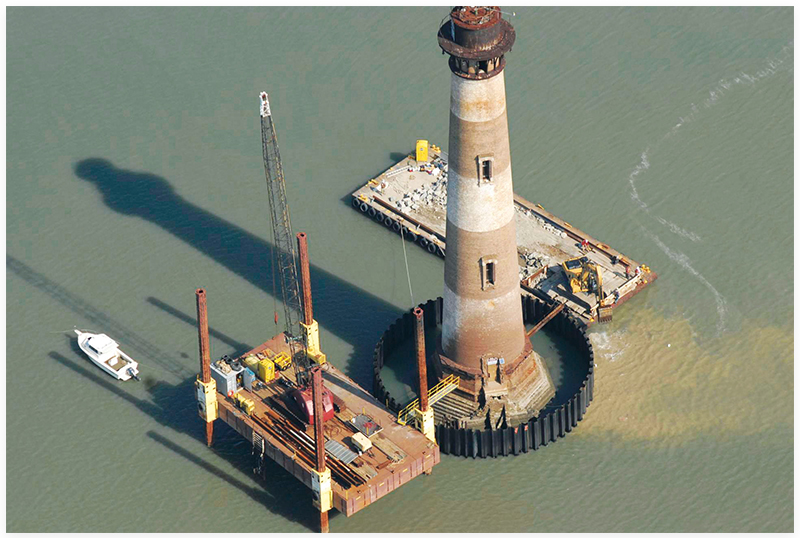
Local advocates and preservationists band together to save the island and its historic light
While Morris Island continues to erode (it is now classified as a “roll over” barrier island, ie, the entire island can flood given tide and weather conditions); what little high ground and history remaining has been preserved, thanks to a cooperative effort between a variety of public entities and private individuals. The fight to save the island was not an easy one. At one point, there was talk of developing the property and building a bridge that would link the island to the mainland. These plans met with fierce opposition, including the Morris Island Coalition, a group of historic preservation advocates and conservationists, and the SC Battleground Preservation Trust. Finally, in 2008, through an agreement brokered by the National Trust for Public Land, the City of Charleston purchased the island for $3 million, including deed restrictions prohibiting development. Today, the Morris Island is overseen by the Charleston County Parks and Recreation Commission and remains accessible only by boat.
On the island’s northern (harbor) end is Cummins Point, encompassing 118 acres of marshlands, maritime forest, and open beach. The first shots of the Civil War were fired from this property; here were Batteries Wagner and Gregg, remembered for the action in July 1863, later made famous in the movie Glory. The area provides outdoor access to nature, surf fishing, and wildlife observation. Amenities are necessarily limited, thus keeping the property in its pristine state and preserving its historical significance.
Encompassing the island’s southern end, as well as the north end of Folly Island, is Lighthouse Inlet Heritage Preserve, containing beach, marsh, and maritime forest habitats for diverse species of plants and animals, including nesting sites for threatened loggerhead sea turtles and Wilson’s Plovers. It is an ideal location for viewing the Morris Island Lighthouse.
In terms of preserving the monument, “it is a never-ending story,” says Richard Beck, a former mayor of Folly Beach and board member of Save The Light, Inc. the nonprofit that purchased the lighthouse in 1999 for $75,000 through a 99-year lease with the state. The group continues to raise funds for its repair and maintenance. They also restored the beacon, which is typically illuminated on major holidays and can be lit in someone’s memory with a minimum donation of $1,000 to Save The Light, Inc. “The light is not only a beloved reminder of the Lowcountry’s maritime past, it’s as important a historical edifice as any in Charleston,” says Beck.
To learn more, visit ccprc.com and savethelight.org.
Photographs by Jon Puckett; courtesy of Douglas W. Bostick; courtesy of Library of Congress; Andy Lassiter; Richard L. Beck; from the Colonel Peter C. Hains collection; from the Faith Ferguson collection; from the Katherine Davis Craig collection, courtesy of Douglas W. Bostick; from the Mrs. Roulain Deveaux collection, courtesy of Douglas W. Bostick; Richard L. Beck; (Lighthouse rendering & Sullivan’s Island Lightouuse) courtesy of Douglas W. Bostick; courtesy of Taylor Bros. Marine Construction, Inc.; Photograph from the Jim Booth collection; from the Katherine Davis Craig collection courtesy of Douglas W. Bostick